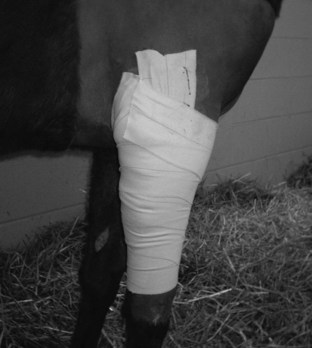Chapter 86Bandaging, Splinting, and Casting
Stable and Traveling Bandages
Bandages used routinely as stable bandages or for transport consist of a padded, quilted, fleece, or an interwoven sheet of cotton as a protective layer, held in place by a flannel wrap or commercially available bandage material. Horses that continually wear stable bandages tend to develop ridges in the hair coat, and this should be noted at a prepurchase examination. Proper bandaging prevents limbs from filling in a stabled horse and helps to prevent injury during transport. The coronary band region is particularly vulnerable during transport, loading, and unloading, and the bandage ideally should extend to cover this area. Alternatively, overreach (bell) boots should be used. Improper bandage application or management can cause the development of white hairs, transient edema, and structural damage to soft tissue structures and, under severe circumstances, pressure necrosis. An excessively tight bandage can result in severe tissue necrosis within 24 hours, resulting in full-thickness skin loss and damage to the underlying soft tissues. The midmetacarpal region seems to be particularly vulnerable. Alternatively, commercially available boots can be used for transport, the best of which extend from proximal to the dorsal aspect of the carpus, or the plantar aspect of the tarsus, to cover the coronary band. The use of exercise bandages and boots for protection and support is discussed in Chapter 37.
Bandaging Wounds
Ether Bandages
Ether bandages are used to cover surgical incisions, but they do not provide any compression to the incision. For the ether bandage to stay, the area to which it is applied must be clipped or preferably shaved. Cleansing of the skin with surgical scrub, followed by alcohol rinsing, provides the best environment on which to apply this bandage. Strips of adhesive elastic tape approximately 15 cm in length are cut, and ether is applied to the adhesive side of the bandage tape. The ether-soaked bandage is then applied over gauze sponges and held in place while the ether evaporates and the adhesive dries to the skin and elastic tape. Three or four strips of elastic tape typically are used. Ether bandages are extremely adherent and very useful to protect surgical wounds made for stifle arthroscopy, bone grafts from the tuber coxae, and plate fixation of the olecranon (Figure 86-1). Because of the explosive nature of ether, proper precautions should be followed in its use and storage. Commercially available Primapore (Smith and Nephew) or Coverderm (DeRoyal, Powell, Tennessee, United States) dressings provide a simpler alternative but are less adherent.




